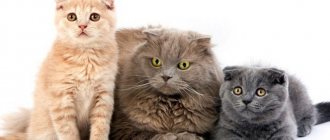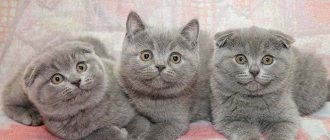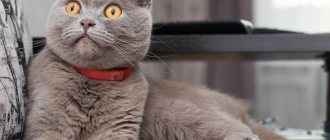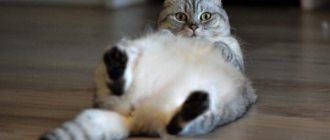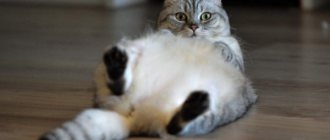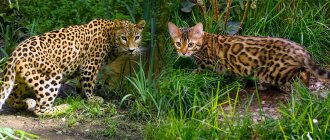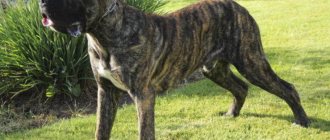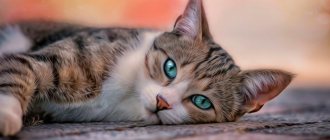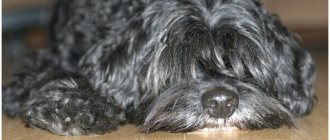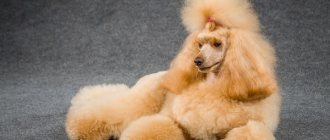Scottish cats have different colors. Scottish cats are famous because of their charming appearance and variety of colors. The color of kittens directly depends on certain genes. As a rule, these are two main shades, black and white.
Scottish Straight colors, for example, are gray with black stripes around the entire body. They are distributed as a percentage. That is, the animal’s fur is painted in two colors in different proportions. Its own gene is responsible for the dominance of one color or another.
Plain (solid)
The color of Scottish Fold cats is monochromatic and they should not have any other color. The fold-eared cat can be of the following colors: white and black, chocolate and lilac, blue and red, cream, fawn and cinnamon. The most popular color in the world among solid Scottish cats is blue. These are the majority of cats.
White
The white Scottish Straight cat can have different eyes, from blue and bright orange to rich amber and copper. Kittens of this variety remain white for the rest of their lives. If kittens have spots, then an adult cat remains white for the rest of its life.
Black
The Scottish Fold black cat is mostly bright in color. A couple of white hairs are acceptable, but if the cat has large red and brown patches, then it is not a purebred.
Black Scottish Fold cats should be bright black in color and their ears, like all fold-eared cats, should be pressed to the head, unlike straight-eared cats. A straight-eared black cat always has its ears erect.
Chocolate
The chocolate Scottish Fold looks impressive. The chocolate color is quite rare. Brown fold kittens should have a smooth, uniform coat of chocolate color. The dark brown coloring adds nobility to the cat.
A brown cat gets this color if he has chocolate, chocolate bicolor or chocolate color points in his pedigree. Chocolate Scottish kittens always delight their owners. They look very cool against a light background.
Lilac (lavender)
A lilac long-eared cat gets this color if he has either lilac color points or lilac in his pedigree. The lilac coloration goes well with orange, copper or amber colored eyes and a light brown nose. This color is also called coffee with milk.
Blue color (blue)
The Scots Blue can have a coat color of many shades of blue. Some cats may have a fur color closer to gray, and some closer to blue. Each hair must be saturated, then the coat will be perfectly blue.
A bit of genetics
Many people are interested in learning how the colors of Scottish cats are formed. In Scottish cats, two genes predominate, responsible for black and red coat colors. Each of them can act as a dominant (suppressing weaker genes) and recessive (suppressed gene). And there is a third diluent gene, responsible for the saturation of the pigment. Combining in a certain order, these genes can give completely unimaginable coloring.
The presence of one color or another in a Scottish kitten cannot always be determined in the first weeks of life. This is not the final shade yet, because the coloring becomes brighter and more pronounced only when the coat is replaced by an adult during the baby's molt. This happens around six months of age. But up to 2 years, the shade may still change slightly.
Bicolors
The coat color of these beautiful creatures has two colors, and a combination of white and any other shade is mandatory. Purebred bicolors must have a white belly, neck, chest, chin, limbs and, of course, muzzle.
Particolor (calico)
A Scottish cat of this type, called particolor, is a combination of white with tortoiseshell or spotted tabby color.
Harlequin
Harlequin captivated everyone with his unusual appearance. The cat is painted white (4/5 parts of the body), but the tail must be black, as well as the ears and the top of the head. The ventral part is white. The tip of the nose, like most people, is the same color – pink.
Wang
This breed only has colored tail, and sometimes has a few spots on the head. It happens that there are solid spots on the paws and back, but this is considered undesirable. When this breed develops red spots, it may also be called a Red Van.
Matching eye color to coat color
Until four months it is impossible to determine eye color. It can be identified by its fur, the shade of which may change. There is a special table by which you can determine the eyes of an animal. It must be remembered that the final result cannot be guaranteed, but in the vast majority of cases it coincides with the data in the table.
Table of correspondence between eye color and coat color of Scottish cats.
Color point
The Color Point is a rare breed of Scottish cat with a color similar to that of a Siamese cat. In childhood they look a little like Thai kittens. The main background is white or cream. The muzzle, ears, paws and tail are painted in darker shades. Color point or links point have blue eyes.
They acquired their colors from their British ancestors, who had Persians with this shade in their family. By the way, it is very difficult to distinguish a British cat from a Scottish one, and even professionals cannot always do this.
Description and features
The cat is slightly larger than average in size, proportionally built, the body looks tightly “knocked together”. The coat is thick, soft and elastic to the touch, and fits tightly to the body. Reminds me of a plush cover. The colors are varied, there are shades of blue and red tones, multi-colored and one color.
The length of adult cats is 50-55 cm without a tail, height 29-32 cm. A cat's weight at 2 years can be 4.3-9.1 kg, and that of a cat 2.5-6 kg. Let us present to your attention a description of the cat based on the standard parameters.
- The head and everything that is on it can be called one definition - rounded. The muzzle, eyes, whisker pads - everything has soft rounded outlines, the skull itself is large, the chin is strong. The eyes are not only round, but large and wide open. The color may vary depending on the coat color.
- The nose is quite wide, but not long; the base is noticeable at the forehead.
- The ears, as the name implies, droop, taking on the appearance of a curved fold; the tip of the ear covers the pinna. They should be pressed tightly and not extend beyond the contours of the head. They may have one or two folds. From the tips to the earlobe you should get a small triangle with the apex at 90 degrees on the earlobe. In adult cats, a person's palm can easily be placed between their ears.
- The body is slightly elongated and looks graceful.
- The width of the hips follows the shoulders, the chest is voluminous.
- The legs can be of medium length or longer, strong, muscular, with round graceful paws.
- The tail is of medium length in relation to the size of the body, sometimes longer, mobile and flexible, tapering at the end. Typically, the longer and more tapered, the more expensive the cost of the animal. Ends with a round tip. A movable tail is valued, since deformities of the joints of this organ occur in the breed.
The Scottish Fold in the photo looks very much like an owl. Large and round eyes on a large head, a prominent nose and an attentive, slightly frightened look. And also dense fur, like thick down. And the ears are almost invisible. Here is such a “bird beast”.
Tabby (tabby)
Tabby is one of the most popular cats among Scots. The color of Scottish tabby cats is distinguished by the presence of a pattern in a certain area on the coat. The pattern on the wool can be anything. A distinctive feature is considered to be a pattern in the form of the letter M on the forehead.
Tabby color depending on the type of pattern:
- striped like a tiger (has vertical stripes on the sides);
- spotted;
- marble (pattern of chaotic spots and stripes of different sizes).
And depending on the color combinations to the following:
- golden tabbies;
- cream tabby;
- blue;
- black marble;
- marble on silver
- silvery blue (gray tint);
- silver (silver color);
- cameo.
RARE COLORS
Ticked
An extremely rare Scottishfold color. These kittens are very expensive. The peculiarity is the coloring of the fur hairs. Sometimes it is called "Abyssinian". Each hair must have at least three dark stripes. It looks like small specks on the fur. Stripes on the paws and on the tip of the tail are allowed. The letter "M" and a necklace of stripes around the neck. This color is also called “pattern without pattern.” Yellow, dark orange, orange eye color, for silver ones – green.
Chinchilla
Rarely seen, elegant color. Only 1/8 of the tips of the fur are dark colored. Currently, silver, gold and blue-gold colors are known.
All Scottishfold colors are beautiful, sophisticated and amazing in variety. These cats are funny and cute, surprising with their habits. Therefore, the Scottish breed is loved all over the world. And no matter what kitten you choose, it will bring you many pleasant moments in its company.
Smoky (smoky, smoky)
The main condition for this color is that the hairs at the base of the body must have a silver-white tint. Those. the silvery-white hair turns into another color, such as black or blue. This phenomenon is called typing and occurs as a result of a dominant silver gene. The smoke can be different, for example, chocolate.
There are often cats with additional patterns on their fur, but according to color rules this should not be the case.
Don't confuse this color with a solid color! If you're not sure, part your cat's fur and see what color is at the base of his fur.
Tortoiseshell
The Scottish Fold cat of tortoiseshell color (photo below) has a coat on which dark spots are evenly combined with red or cream.
The following varieties of this color are distinguished:
- black-red;
- chocolate red;
- blue-cream;
- lilac-cream.
Important! Only cats can be tortoiseshells. Males of this color are a deviation from the norm.
Shaded
Shedded (shaded color) is the third variation of typing colors. These cats have ⅔ white hair and ⅓ colored hair. Tipped fur does not cover the entire body, but only the back, sides, back of the head, neck, and tail. White coat - on the belly, chin, and lower part of the tail.
Shedded is represented by coloring pages:
Photo of “Scots” of shaded color:
White based colors
These colors of Scottish breeds are:
- Bicolor. Two-color ones, in turn, are presented with the addition of the following colors to white: blue, black, cream, red. The muzzle, abdomen, limbs and thighs remain entirely light. The eyes are the color of gold or sky. Such tartans can have eyes of different colors.
- Wang. Almost all the fur is white, only the tail and a couple of markings on the head are colored.
- Harlequin. The edge is mostly white, only a fifth of the surface is colored.
- Ticking. All fur with distinct ticking. The eyes are all shades of gold; those with a silver color are greenish.
Harlequin
The name was given because the owner of the color is similar to a harlequin. The main color of the coat is white. And only ⅕-⅙ of the body area are colored spots. They are not concentrated in one area, but can be scattered throughout the body.
Photos of harlequin cats:
Nutrition
You can choose natural food for feeding - boiled lean meat (chicken, beef), as well as raw meat (kittens need to be finely chopped or given minced meat), chicken and beef offal (for dark breeds), boiled sea fish, boiled egg yolk, cottage cheese , kefir and other lactic acid products, cereal porridges, sprouted grains of oats and wheat.
Add vitamins, minerals, calcium and stomach hair removal paste. Sometimes give your cat brewer's yeast, dried kelp, fruits or vegetables. These are sources of vitamins and fiber. You can feed them with ready-made premium food or on a natural basis. Don't forget about clean drinking water.
How to choose a kitten
Scottish straight kittens are just as adorable as fold kittens. Before buying a baby, study the breed standard and choose a nursery with a license to breed Scots.
Healthy Scottish cats smell pleasant, have lush and shiny fur, clear expressive eyes, a soft, non-bloated belly, and clean fur under the tail.
Trouble-free kids willingly join in the game and show a keen interest in strangers. Lethargic kittens are most likely sick with something.
Observe the character of the parent couple. This will help you understand what traits the kittens will inherit.
International system of classification of colors and other external characteristics of Scottish cats
An important factor when choosing a Scottish kitten is its color. However, it is worth considering that the pattern on the fur will become relatively clear and understandable by the age of 3 months of the animal’s life. But you can accurately determine the color only by 6-7 months! It often happens that certain marks on a kitten's fur disappear as it grows. The price of a cat is primarily influenced by color, more details in this article.
In the world, it is customary to divide cats by color according to the international classification system (WCF).
The color code looks like this: xx.NN.NN.NN. (NN), namely:
| x | NN. | ||||||
| (can combine 2 signs - xx) | (can combine up to three pairs of signs (NN.), the fourth (NN) is additional | ||||||
| first digit “0” of the code (presence of white color) | first digit “1” of the code (presence of tipping) | the first digit of the code is “2” (presence of tabi color) | the first digit of the code is “3” (presence of point color) | the first digit of the code is “5” (tail length) | the first digit of the code is “6” (eye color) | the first digit of the code is “7” (ear placement) | |
| a – blue - blue | 01 –van-van | 11 — shaded (the hair is darkened in the upper part by 25%) | 21 - tabby, agouty - striping, agouti factor | 31 — Burmese color | 51 – rumpy – tailless (Manx breed) | 61 - blue | 71 - straight ears - straight ears or “straight” |
| b - chocolate (brown, chestnut) - chocolate, chestnut, brown, Havana | 02 - harlequin | 12 - tipped, shel - veiled (the hair is darkened in the upper part by 12.5%) | 22 - blotched, marble - marble | 32 - tonkinese color - Tonkinese | 52 -rumpy riser - tail with 1-2 vertebrae (bob-tail) | 62 – yellow, golden – golden, yellow, red | 72 – curled ears – ears curled back or “curl” |
| c –l ilac(lavender) – lilac, lavender, platinum | 03 - bicolour-two-color, bicolor | 23 - mackerel, tiger - tiger | 33 – Himalayan(siam) color – Himalayan (Siamese) | 53 – stumpy – tail from 7 to 13 cm when curled | 63 - oddeyed - odd-eyed | 73 – folded ears – ears curled forward or “fold” | |
| d - red, flame - red | 04 - mitted/white point - with white markings (color-points) | 24 – spotted – spotting | 34 - singapura color - Singaporean | 54 - longy - normal long tail | 64 - green - green | ||
| e - cream - creamy | 05 - snowshoe -snow-shu | 25 – ticked | 35 - abyssinian color - Abyssinian | 65 – Burmese – eye color in Burmes cats | |||
| f – tortoiseshell - tortoiseshell | 09 – little white spots – individual white spots (“collar”, “socks”) | 66 – tonkinese – eye color in Tonkinese cats | |||||
| g- blue – cream - blue cream, blue tortoiseshell | 67 – Himalayan or siam – eye color in Himalayan (Siamese) cats | ||||||
| h - chocolate-tortie - chocolate tortoiseshell | |||||||
| j - lilac-tortie-lilac tortoiseshell, lavender tortoiseshell | |||||||
| n - black, ebony, seal, sable, ruddy - black, seal, sable, wild | |||||||
| o - sorrel, cinnamon, honey - sorrel, brown, red-brown, honey | |||||||
| p - beige fawn - yellow-brown | |||||||
| q – sorrel tortie – red-brown tortoiseshell | |||||||
| r - beige fawn tortie - yellow-brown tortoiseshell | |||||||
| s - silver, smoke - silver, smoky | |||||||
| w - white - white | |||||||
| y - golden | |||||||
| x - unregistered - unrecognized color without registration | |||||||
For example, the color code “red bicolor tabby (tabby)” would look like this: d0321.
Red spotted tabby bicolor – d2403
▲ to contents
Character
The character of the Scottish Fold is calm, accommodating and sociable. The animal is not capricious, unpretentious in everyday life, and behaves balanced. It becomes very attached to its owner and its habitat. Doesn't like to attract attention to himself by meowing. What needs to be especially noted here is the cat’s voice.
It doesn't sound like a normal purr, it sounds slightly like a cold, even squeaky. It is clear that the cat does not really like to bother someone. These cats have a very interesting feature - they calmly stand on their hind legs.
They simply stand up and look at what interested them, but was difficult to see from below. Some can even stand like this for a long time, reminiscent of desert animals - meerkats. They also sleep comfortably on their backs. Scottish Fold kittens are cheerful, affectionate, playful, get used to being handled, and can be trained.
They can often be seen at various performances. They quickly get used to the scratching post. Good companions for both adults and children. They don't like noise and can get scared. If you have a small child, it is better to adopt a pet at the age of 3-4 months. They are already socially adapted and understand the basics of independent living.
I would like to note the innate nobility of these animals. Their presence has a positive effect even on dogs, although cats and dogs are usually two irreconcilable categories. And a few words about his delicacy. The cat cannot stand loneliness, but you may not even notice it. He will very tactfully and quietly settle down somewhere nearby.
History of the breed
The ancestor of the Scottish Fold is considered to be a white cat named Susie. It was discovered on a farm near Cupar Angus in Perthshire (Scotland) in 1961. Susie's ears had an unusual curve in the middle, making her resemble an owl. The owner of the farm became interested in such an unusual appearance and decided to keep the cat.
Soon she calved, bringing three kittens with folded ears. One of them was purchased by neighboring farmer and cat lover William Ross. In 1966 he registered the breed with the Governing Council of the Cat Fancy (GCCF), a serious and established organization that has maintained a register of breeding cats in the UK since 1910.
From that moment on, the Scottish Fold breed . Geneticist Pat Turner helped him. In the first three years of the program, 76 kittens were produced, 42 of them with folded ears, 34 with straight ears. It turns out that the famous ear is the influence of a dominant gene, a mutation process.
The first cat with such “wrong” ears, as it was believed, was the ancestor of the world-famous breed. In 1971, the breed was introduced to Europe, but it was not accepted, so the GCCF withdrew its registration. There were many reasons - scientists thought that some cats had deformities in their limbs and tails, which they mistook for a deformity.
There have also been comments about genetic difficulties and ear problems such as infection, mites and deafness. But enterprising Americans purchased cats with folds on their ears, and the breed has already begun to spread throughout the world. American Scottish folds and European ones appeared.
Subsequently, the Scottish Scottish Fold was crossed with the British Shorthair and American Shorthair. By the way, after the first complaints, the breed did not have problems with mites and infections, although these cats may have more wax discharge in the ears than others.
Reproduction and lifespan
A Scottish Fold cat is allowed to be bred no earlier than two years of age. They are bred only with “straight” cats, and vice versa, “fold” cats with straight-eared cats. To pair a “fold”, they select not just any straight-eared breed, but a descendant of a similar mating.
This helps to avoid hereditary bone abnormalities that occur when mating two “folds”. By the way, our “fold” also does not need to be crossed with the British, there may be kittens that do not fall under the standard. Both producers must be healthy and vaccinated. Mating takes place only on the cat’s territory or in any convenient place.
But not in the cat's house. As soon as the gentleman has lost interest in the lady, you can take the cat home. The first month of pregnancy of the visloushka passes unnoticed by anyone. Pay attention to her feeding. If you fed your cat ready-made food, switch to kitten food. There are manufacturers of food specifically for pregnant cats.
In the second month of pregnancy, the cat needs to be fed 3 times a day. Prepare her birth box and introduce her to it. Let her get used to the “children's house”. Pregnancy lasts 60-65 days, maybe a little more. Don't be alarmed if your kitty tolerates a little. Childbirth lasts about a day. Keep an eye on her, she needs your attention.
Yes, and to avoid trouble. There can be from 1 to 6 kittens, but usually 3-4. In each litter, cats can have both “folds” and “straights”. For the first two weeks, you don’t even have to remember about them; the mother cat does everything. She washes them, feeds them, warms them, cleans them. Then they begin to crawl, by the 4th week they can begin to be fed with fermented milk products, soaked food or finely chopped meat.
By the end of the 4th week they will start to climb out of the box, it's time to show them the litter box. These animals are a real joy in the home, and it is important that they live longer. With normal care, feeding and care, pets live up to 10-15 years.
Care and maintenance
If you decide to purchase a pet such as a Scottish Fold , first arrange for a cat. It is necessary to buy a tray, food and toys in advance so that the baby can immediately adapt to the new place.
The list of mandatory care measures includes:
- Combing. Use a stiff or wire brush. Comb several times, both with and against the coat. These cats love to be brushed against the grain.
- Ears. Clean them carefully at least once a week. They sometimes have excessive sulfur output, which must be removed.
- Eyes. Lightly wipe your eyes with the end of a cotton pad soaked in boiled water once a week.
- Claws. They often know how to use a scratching post. But if you are not accustomed, try to trim once a month.
The animals are not usually sickly, but they do have genetic problems. Bone diseases are the most common. Moreover, these sores can occur at any age - the skeleton may become deformed, the tail may become inactive, or the limbs will begin to thicken. This is called osteochondrodysplasia.
If you notice a change in your pet’s gait, see that he reacts painfully to touching his tail, has no desire to jump, or has a squat appearance in his figure, contact your veterinarian immediately.
It is necessary to monitor the pet's health. In addition, they are susceptible to heart disease, bronchitis, and diabetes. These diseases are not congenital, and also require timely diagnosis and treatment.
Chinchilla
The Scottish chinchilla borrowed the extravagant colors of its coat from the British, and they, in turn, from Persian cats. A chinchilla kitten is born only from parents with an unusual color. Each hair is colored in two colors.
Most of it is light in color and 1/8 of it (the top) is dark in color. This phenomenon is called tipping.
Tipped chinchilla colors can be of 3 types:
